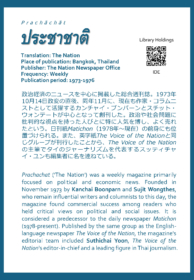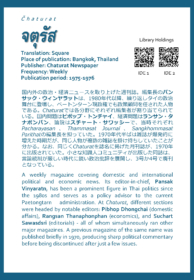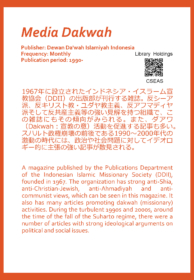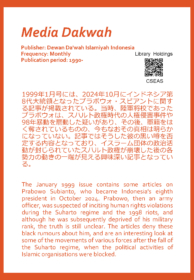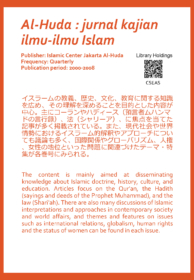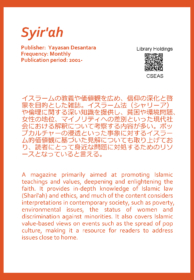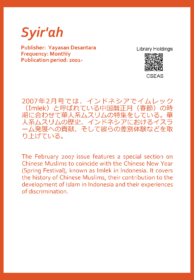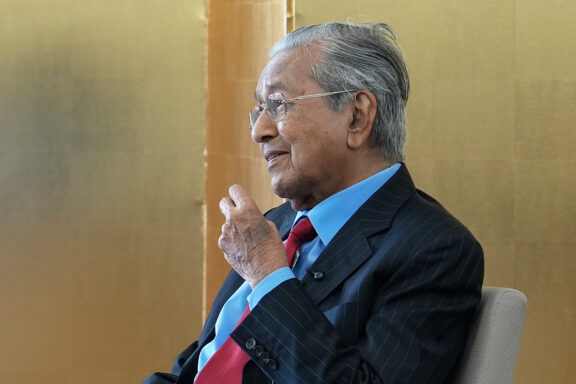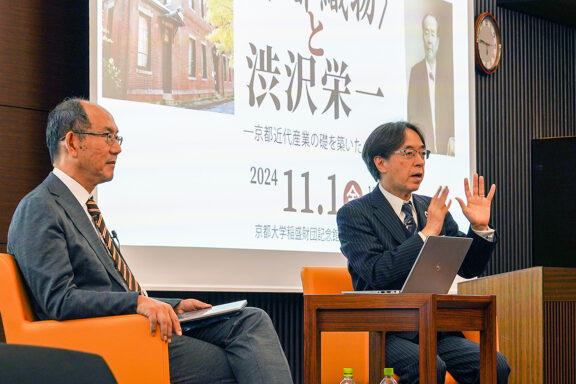Minami Tosa (CSEAS Library) and Marie Kobayashi (Institute of Developing Economies (IDE) Library)
The Library of Center for Southeast Asian Studies (CSEAS) has had a joint use system agreement with the Library of the Institute of Developing Economies of the Japan External Trade Organization (hereinafter referred to as the “IDE Library”) for the past ten years. To mark the conclusion of the agreement and to promote further cooperation and utilization of our respective collections, our two libraries jointly held an exhibition of “Journals from the Turbulent Times of Southeast Asia” from November 25 to December 20, 2024.
The exhibition included rare journals from Southeast Asia held by both institutions together with explanatory notes. The CSEAS Library’s contribution featured Indonesian Islamic journals published in the 1990s and 2000s, while the IDE Library’s contribution featured Thai-language review journals from the 1970s and 1980s, donated by Professor Emeritus Osamu Akagi of Osaka University of Foreign Studies. Although small, the exhibition could only have been undertaken by these two institutions, which each holds valuable collections from the Southeast Asian region.
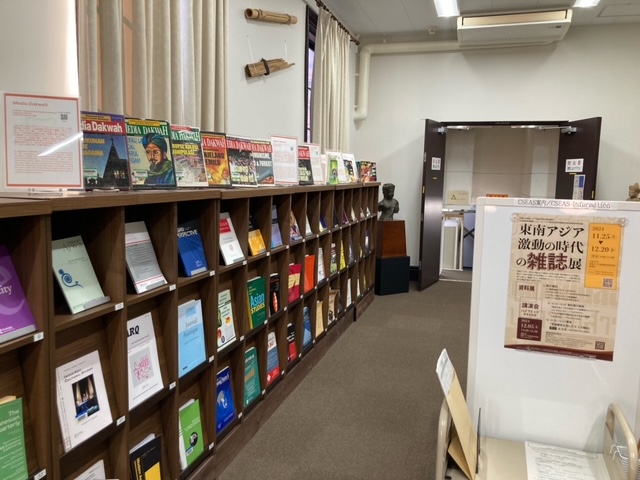
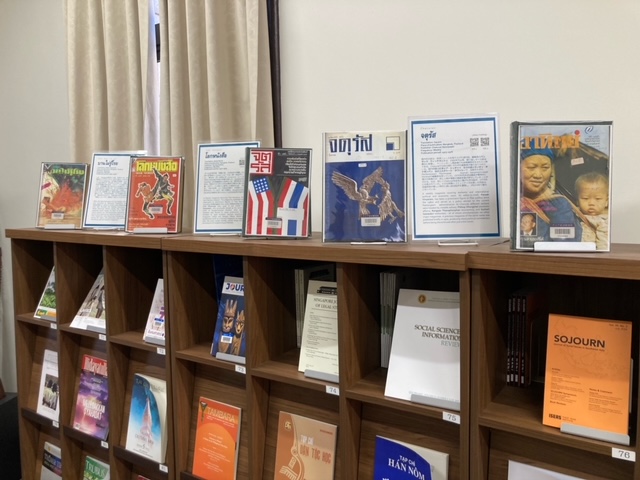
As part of the exhibition, Professor Akagi offered a lecture on “The Rise of Thai Magazine Culture and its Impact on Public Expression.” At the lecture, librarians from CSEAS and IDE first explained the materials in the exhibition.
Journals from Turbulent Times in Indonesia and Thailand
First, Minami Tosa presented some Indonesian journals related to Islam held by the CSEAS Library. With the fall of the Suharto regime in the late 1990s, Indonesian publishing activities, which had been suppressed, became more active. At the same time, Islamic forces, whose political activities had been severely restricted until then, also became active in publishing. Reflecting this context, various aspects of Islam and a range of Muslim voices in Indonesia are presented in the collection’s journals.
For example, the monthly magazine Media Dakwah contains several ideologically charged articles that are anti-Jewish and Christian, critical of Islamic minorities, and hostile to communism. Numerous articles are also highly critical of the government at that time, which took a tolerant attitude toward other religions and sects. The journal Syirʹah, on the other hand, tends to express a view of Islamic values based on religious tolerance. Syirʹah also explores social issues related to Muslims in Indonesia, such as conversion and women wearing the jilbab, and provides a resource for thinking about issues close to the daily lives of Muslims.
Marie Kobayashi, librarian at the IDE Library, then introduced the journal Sangkhommasāt Parithat (Social Science Review) from Thailand. The publication, which had been established before 1973, witnessed and reflected the tumultuous period of increased publication of critical journals after the 1973 political upheaval in Thailand and the subsequent resumption of speech control. The pioneering journal provided a forum for academics and intellectuals to express and exchange views on social systems. It can be regarded as a pioneer of discursive space and a driving force of political change.
We also introduced various innovations that journals used to continue publishing under the unstable conditions of the time. For example, we note mysterious changes to the publication schedule of Pāčhārayasān, which was launched as a special edition of an existing magazine without applying for a publishing license in the wake of the political upheaval in Thailand.
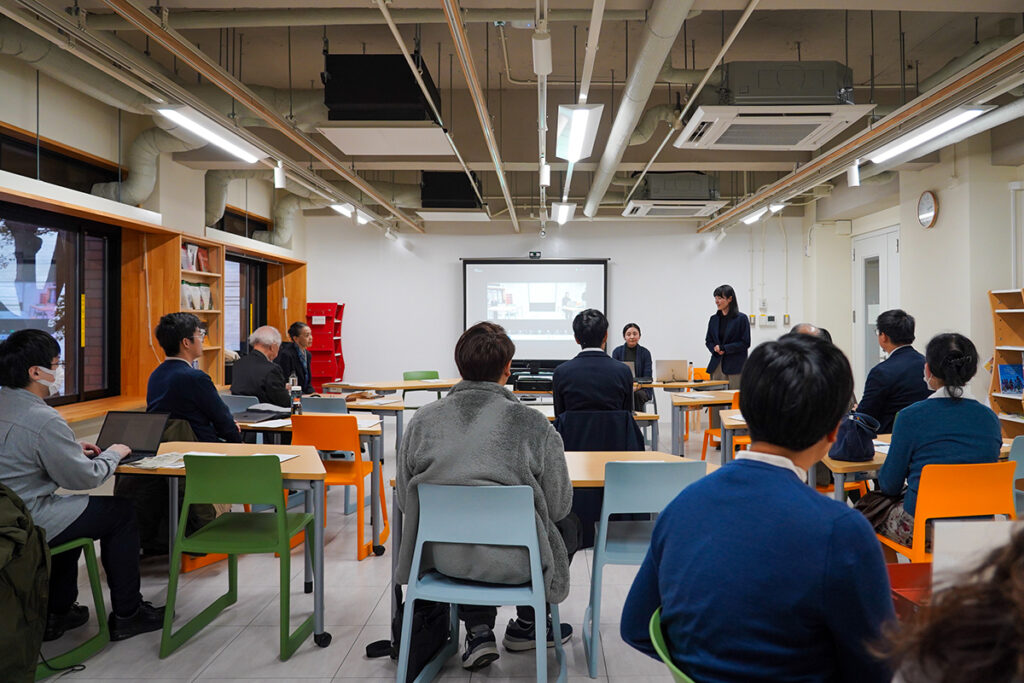
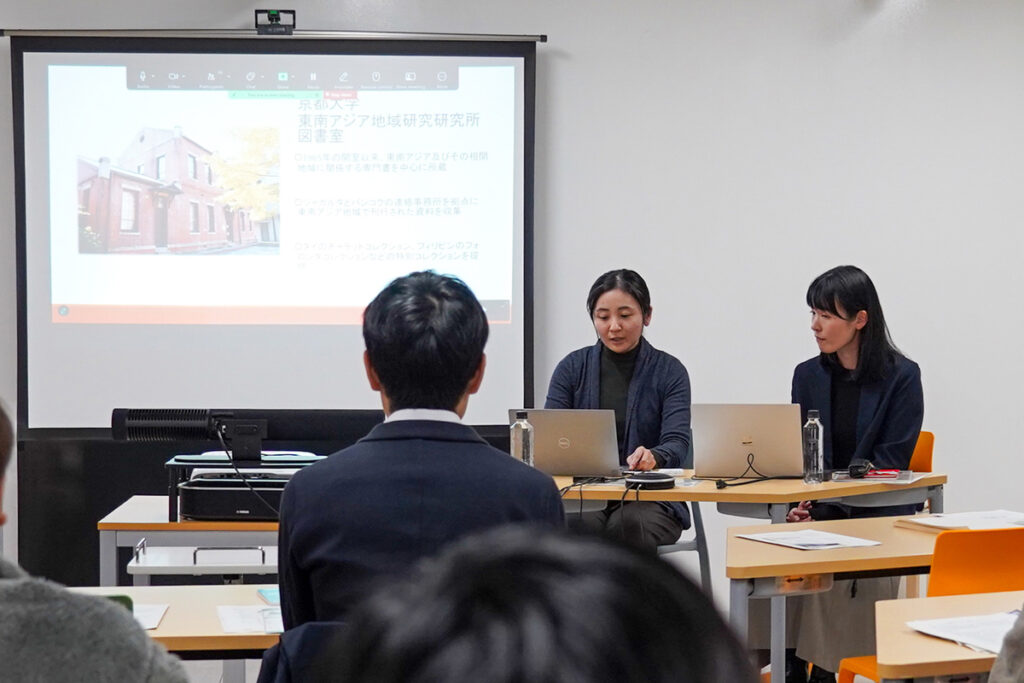
A Special Lecture on Thai Magazine Culture and its Impact on Public Expression
The Thai-language journals in the exhibition are not only a source of information on long-term political and social trends, but also are valuable primary sources for understanding the publication history of journals in the region. Professor Akagi shed light on this during his lecture. He noted that in Thailand’s journey towards democracy, magazines played a crucial role, especially during the 1970s. Despite strict government control over what people could write, several magazines emerged and became a powerful voice for change. This explosion of new publications reached its peak between two important events in Thai history: the student-led uprising of October 14, 1973 and the “October 6 Incident” of 1976.
Professor Akagi, who witnessed this turbulent period firsthand, shared his experiences of collecting these important magazines in the lecture. Having lived in Bangkok for three different periods from the late 1960s to the 1980s, he gathered numerous magazines that captured the spirit of social change. These magazines, which he later donated to the IDE Library in Japan, featured articles by students and intellectuals who went on to become important figures in Thai politics and academia.
One of the pioneering magazines was Sangkhommasāt Parithat (Social Science Review), first published in 1963, when starting new periodicals was still very difficult. Professor Akagi explained that the “epicenter” of this publishing revolution was the bookstore Suksit Siam, opened by Sulak Sivaraksa, who also founded Social Science Review. The bookstore became a meeting place for writers, young students, and thinkers who would gather to discuss Thailand’s political future. This led to the creation of new publications, including the Student Edition of Social Science Review (1966–1971).
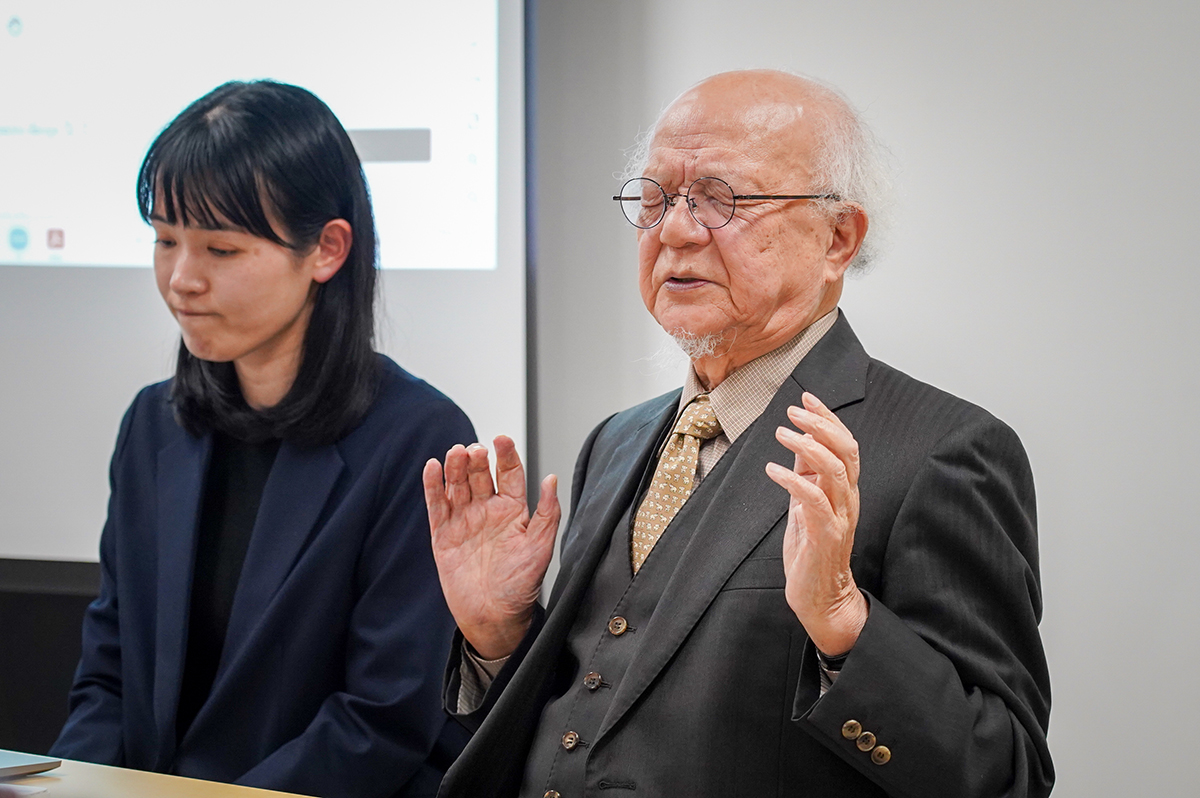
Professor Akagi’s collection, comprising approximately 30 different periodicals, includes many titles that no longer exist in Thailand. After the October 6 Incident in 1976, the government began strictly controlling publications again, and many were seized and destroyed. Professor Akagi’s collection survived thanks to a friend at the Suksit Siam bookstore who warned him about the danger and helped him store the magazines safely with his personal contact in Bangkok. Thanks to this quick thinking, these rare magazines are now preserved in Japan, providing valuable insights into Thailand’s path to democracy.
Thanks to the collaborative efforts of our two institutions, we were able to disseminate information on valuable materials and hold a very meaningful lecture on the topic of journals. We hope to continue to execute projects that make the most of the characteristics of both specialized libraries.
Appendix: Explanatory Notes for the Exhibition
Thai-language review journals from the 1970s and 1980s
Indonesian Islamic journals published in the 1990s and 2000s
About the authors:
“70万冊の知識を未来へ!アジア経済研究所図書館 (700,000 volumes of knowledge for the future! IDE Library),” Interview with Marie Kobayashi, Institute of Developing Economies, December 17, 2024 (in Japanese).
“New Staff: Minami Tosa,” CSEAS Newsletter, September 11, 2024.
This article is also available in Japanese. >>
「東南アジア激動の時代の雑誌展」
(土佐美菜実・小林磨理恵)


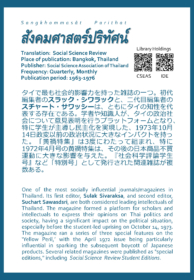
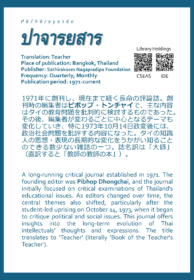
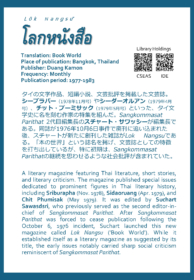
![ʿĀthit อาทิตย์ Translation: Sun Place of publication: Bangkok, Thailand Publisher: Samnakphim Athit Frequency: Weekly Publication period: 1977-[2000] Athit(タイ語で「太陽」の意)は、1977年創刊の週刊誌。タイの週刊誌としては異例の長さとなる20年以上にわたって発行された。編集長のチャチャリン・チャイヤワットは、以前に週刊誌Prachachatの記者として経験を積んだ。政治的な事由を背景に、本誌は誌名を変更しながら発行を継続。Athitから始まった誌名は、Sayam Nikhon(シャムの人びと)Matuphum(母国)、Sayam Mai(新しいシャム)、Khlet Lap(秘訣)、Wiwat(進化)と変更され、最後は再びAthitに戻る。社会や政治を鋭く批評する進歩的な論調で知られた雑誌である。 Athit, a weekly magazine launched in 1977, had an exceptionally long run of more than 20 years for a Thai publication of its kind. Editor-in-chief Chatcharin Chaiyawat had previously worked as a reporter for the weekly magazine Prachachat. Due to political circumstances, Athit continued publication while changing its title several times. Starting as Athit, the title changed to Sayam Nikhon (People of Siam), Matuphum (Motherland), Sayam Mai (New Siam), Khlet Lap (Inside Knowledge), and Wiwat (Evolution), before finally returning to Athit. The magazine was known for its progressive editorial stance that offered sharp observations on social and political issues.](https://newsletter.cseas.kyoto-u.ac.jp/wp-content/uploads/cache/2025/01/nl82-report-zasshi-07/2144378774.jpg)
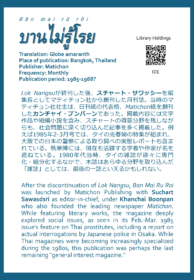
![Sūn ศูนย์ Translation: Center Place of publication: Bangkok, Thailand Publisher: National Student Center of Thailand Frequency: Twice a month Publication period: 1974-[197-?] 学生の全国組織であるタイ全国学生センター(NSCT)の機関誌。NSCTは、1972年に日本商品不買運動を主導して影響力を強め、民主化を実現した1973年10月14日政変においては決定的な役割を担った。Sun(センターの意)は、政変直後の1974年1月15日に創刊。創刊号には憲法制定要求により逮捕された13人に対するインタビューが掲載される。学生運動の指導者で、 NCST元書記長のティーラユット・ブンミーが憲法を請願する理由も語られている。主に民主主義、階級の問題を取り上げ、同時代に発行された雑誌の中でもとりわけ急進的だといえる。タイ国内にはおそらく残されていない、貴重な雑誌である。 Sun, meaning 'Center', was the magazine of the National Student Center of Thailand (NSCT). First published on January 15, 1974, its inaugural issue featured interviews with 13 activists arrested for demanding a constitution, including former NSCT Secretary-General Thirayuth Boonmee, who explained the rationale behind the constitutional petition. The NSCT had emerged as a powerful force in Thai politics after leading the successful boycott of Japanese products in 1972 and playing a pivotal role in the October 14, 1973 uprising. Among other magazines of that era, Sun was known for its radical stance, focusing heavily on democracy and class issues. This rare magazine is believed to no longer exist within Thailand.](https://newsletter.cseas.kyoto-u.ac.jp/wp-content/uploads/cache/2025/01/nl82-report-zasshi-09/312833888.jpg)
